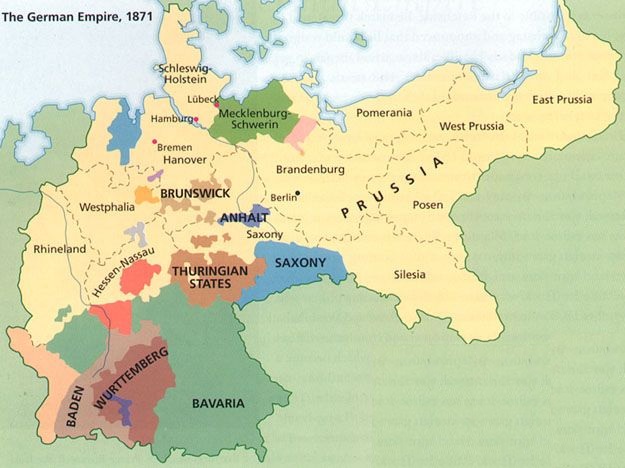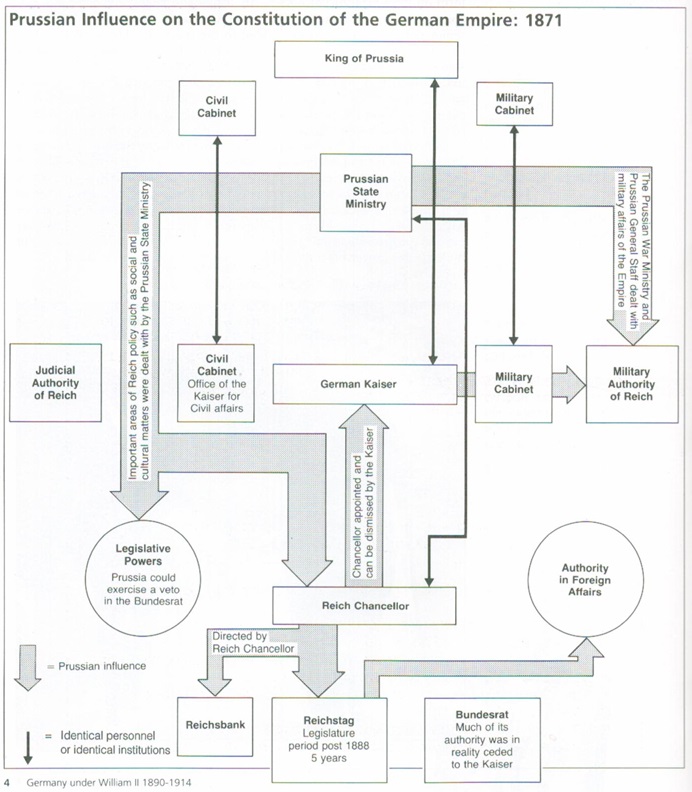Background
 For most of the 19th century, ‘Germany’ was a collection of tiny independent states, with one powerful kingdom (Prussia – see map). In 1871, however, after winning a war against France, the states declared a ‘federal government’ named the
Deutsches Reich (‘German Empire’). For most of the 19th century, ‘Germany’ was a collection of tiny independent states, with one powerful kingdom (Prussia – see map). In 1871, however, after winning a war against France, the states declared a ‘federal government’ named the
Deutsches Reich (‘German Empire’).
Germany’s first Chancellor (chief minister), Otto von Bismarck, was VERY conservative, hated the Catholic Church, and brought in a law (1878) to persecute Socialists. In foreign policy, after the initial wars of unification, Bismarck was conciliatory with other nations, organised the Conference of Berlin (1884) to divide up Africa between the imperialist countries of Europe, and made a Reinsurance Treaty with Russia (the country he thought most dangerous to Germany)
In 1888 Wilhelm II became the young (29 years old) Kaiser of
Germany.
|
Going Deeper
The following links will help you widen your knowledge:
Basic revision notes from
BBC Bitesize

Blacks Academy on the Structure of Wilhelmine Germany
YouTube
Really useful Revisely video on
Kaiser Wilhelm and the
German Monarchy
Pete Jackson video - really good
|
Difficulties of Ruling Germany
[Kaiser Wilhelm's
Personal Rule Sucks!]
Many historians think that, whilst Wilhelmine Germany was amazing economically and culturally
(and had the best education and welfare systems in the world), it was badly governed:
(Click on the
u orange arrows to reveal more information)
Kaiser
- Historians think Wilhelm meant well, but his rule was a “disaster” (see Source A):
- • The Kaiser appointed
ministers and had the last word on decisions – ignoring, if he wished,
EVERYBODY.
- • He almost immediately got
rid of Bismarck (1890), and chose ministers who looked handsome and did his
will.
- • He bullied and raged at them so that many had “a terrible fear of the Kaiser” and only told him good news and what he wanted to hear.
- • He was too lazy to read documents, and lacked the concentration to listen to reports, so he made decisions hastily.
- • He introduced an Immediatsystem, so lobbyists did not have to go through ministers first.
- • He had Kommandogewalt (command of the Army) so he controlled both the civil AND military decisions of government.
- • He was outspoken and frequently ‘put his foot in it’.
- • The ministers in the end became little more than civil servants – each just got on with their job ‘in a silo’, ignoring the wider impact (so, eg, catastrophically, the Army’s military plan – the Schlieffen Plan – failed to take account of how other countries would react.
Weak, complex government
- The government was a maze of different bodies – Kaiser, Chancellor,
Bundesrat, Reichstag, Army – all with the power to throw a spanner in the works:
- • This diagram of how the
various parts of government interacted shows how labyrinthine it was.

- • The system gave great power to the Kaiser, but also gave the Bundesrat, Reichstag and Army powers to thwart him.
- • The government could not levy direct taxes – only the States could do that – so money was often a problem.
- • Pressure groups like the League of Industrialists, the Agrarian League and the Catholic Church
exerted their influence.
- • The Civil Service was bureaucratic, and hated and tried to stop change.
- • The Government was so restricted that on two occasions (in 1894 and 1912) Wilhelm’s supporrters considered mounting a coup to overturn the 1870 constitution.
Prussian militarism
- Prussia – and Prussia’s needs – dominated the German
government:
- • Prussia had 17 of the 58 members on the Bundesrat
(the Council of the states of the Empire), where only 14 votes were needed
for a veto .
- • The Emperor of Germany was ALSO the King of Prussia (and vice versa).
- • By tradition, the sons of the Prussian nobility (the ‘Junkers’) trained in the Army, and became its officers. They were conservative and militaristic.
- • The Military Cabinet was a separate organ of government in its own right; it was increasingly important in the way the government was run.
Reichstag
- The Reichstag was the parliament of the Empire. In 1926, a German politician said: "The old Reichstag was a useless parliament. It could speak but it had no power." That was not correct:
- • It had to agree all laws, which meant that the Chancellors had to make any proposed laws agreeable to it.
- • It had to agree the BUDGET, which gave it the power of MONEY over policy-making.
- • As time went on, political parties grew up – notably the Centre Party (to protect the Catholic Church) and the Social Democrats (to get a better deal for the working classes) – and the government had to take the views of the Reichstag into account.
Social &economic developments and the growth of Socialism
- By the end of the century Germany was becoming the most powerful industrial nation in the world – especially in iron and steel. But rapid industrialisation brought with it social problems (e.g. factories conditions, low wages, overcrowded and insanitary conditions in the towns):
- • Trade union membership grew; 1889-90 was the year of the Great Strike, involving 715 strikes by 290,000 workers. Bismarck wanted to send the Army to crush the strikes; Kaiser Wilhelm told the Army to protect them, and asked the industrialists to negotiate.
- • The Social Democrat Party grew dynamically in the 1890s, and demanded equal rights and equal power for the working class, and for women. In 1906-10 there were mass-demonstrations demanding a reform of the voting system (which favoured the wealthy), and in 1912 the SDP became the largest Party in the Reichstag.
- • Wilhelm hated and feared political Socialism. He allowed the Anti-Socialist law to lapse in 1890 … but schools were told to teach that Socialism was anti-Christian, and anti-union legislation was introduced in 1899.
|
Did You Know
The German Reich created in 1871 is known as the ‘Second Reich’, on the grounds that the Holy Roman Empire of the Middle Ages was the first Reich.
Source A
[The historian John Röhl] has thus built a formidable case that Wilhelm was a disaster in office.
[Wilhelm] was foolish, mercurial, obsessed, insecure, prejudiced,
megalomaniacal, delusional, paranoid, insensitive, and tasteless.
The fact that such a man exercised virtually untrammeled power in Germany represents the key, in Rohl's eyes, to the German catastrophe of the twentieth century.
Historian Roger Chickering (2016), reviewing Röhl's book
|
Case Study: HOW Wilhelm Ruled Germany
Caprivi’s ‘New Course’
In 1890, Bismarck resigned, and Wilhelm appointed as
Chancellor his Army
chum Leo von Caprivi.
Caprivi and Wilhelm followed a ‘New Course’, which included
co-operating with the Reichstag:
The Anti-Socialist law was allowed to lapse in 1890. Caprivi negotiated trade treaties which reduced
tariffs, and thereby the price of food. Sunday work, work for children under 13, and more than
11 hours work for women, were forbidden. In 1893 he proposed to reduce the length of national service in the Army from three years to two.
At first, Wilhelm was happy with these policies. Caprivi, however, had angered some powerful forces:
Conservatives were calling him a Socialist; The Agrarian League was angry that food prices were falling; The Army was angry at the reduction in National Service; Caprivi was prepared to argue with Wilhelm, and threatened to resign if he did not get his own way – Wilhelm’s courtiers were telling the Kaiser to take on ‘personal rule’.
In 1894, Wilhelm told Caprivi to draw up an anti-Socialist ‘Subversion Bill’. Caprivi refused.
Although he persuaded the Kaiser to drop the idea, he resigned.
Caprivi’s successors, Hohenloe (a 75-year-old conservative) and von Bulow (another army buddy) saw their task as keeping the Kaiser happy.
The ‘New Course’ was dropped, and a new idea of ‘Weltpolitik’
introduced.
|
Consider:
Discuss the Case Study with a friend. How many of the
'Difficulties of Ruling Germany' can you see in action?
- AQA-style Questions
4. Describe two problems faced by Kaiser Wilhelm II’s governments in ruling Germany up to 1914.
6. Which of the following made Germany more difficult to govern :
• the weak, complex system of government
• the
growth of socialism?
|
 For most of the 19th century, ‘Germany’ was a collection of tiny independent states, with one powerful kingdom (Prussia – see map). In 1871, however, after winning a war against France, the states declared a ‘federal government’ named the
Deutsches Reich (‘German Empire’).
For most of the 19th century, ‘Germany’ was a collection of tiny independent states, with one powerful kingdom (Prussia – see map). In 1871, however, after winning a war against France, the states declared a ‘federal government’ named the
Deutsches Reich (‘German Empire’).
